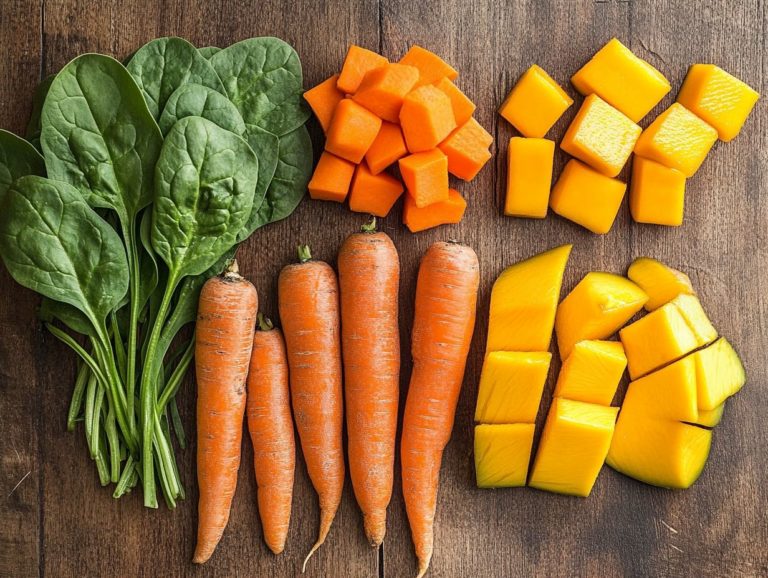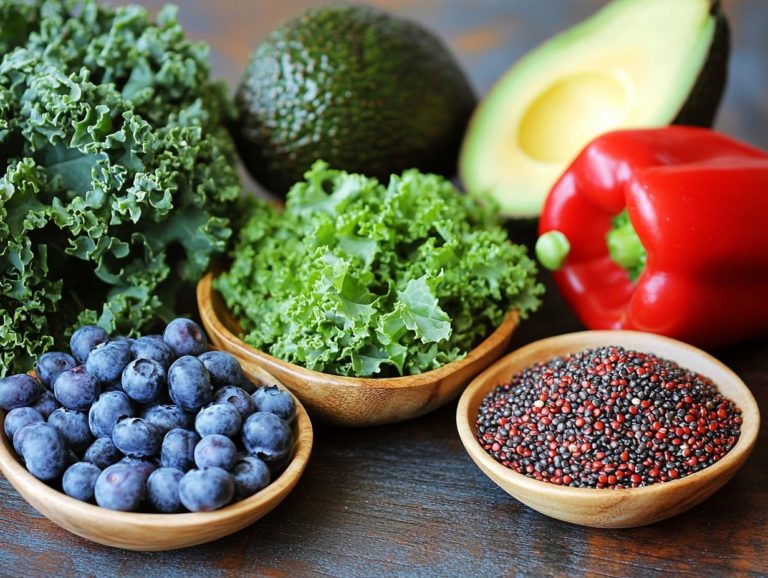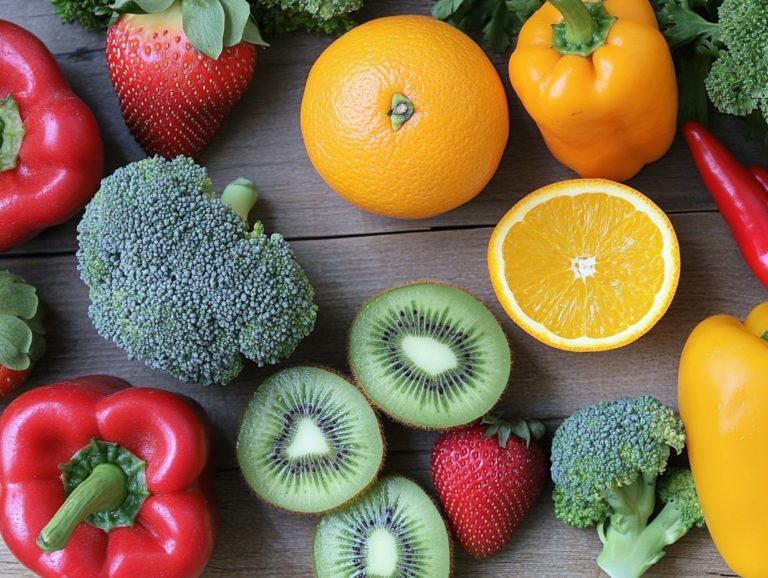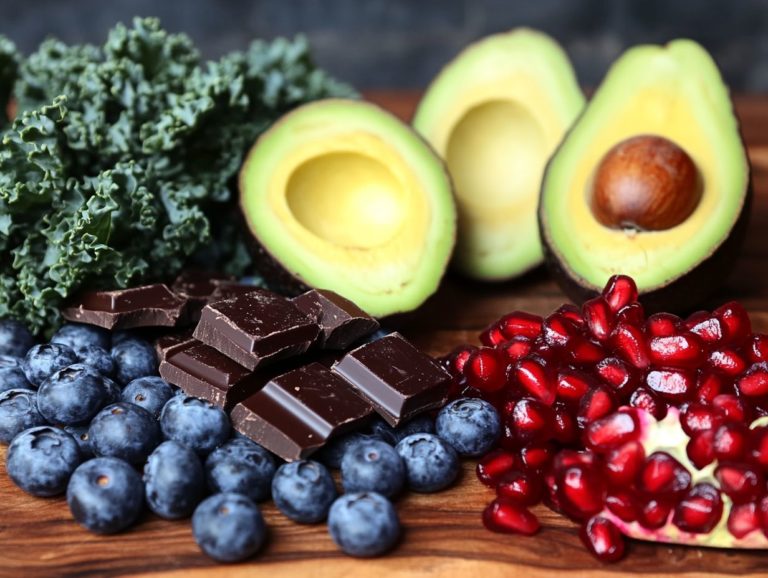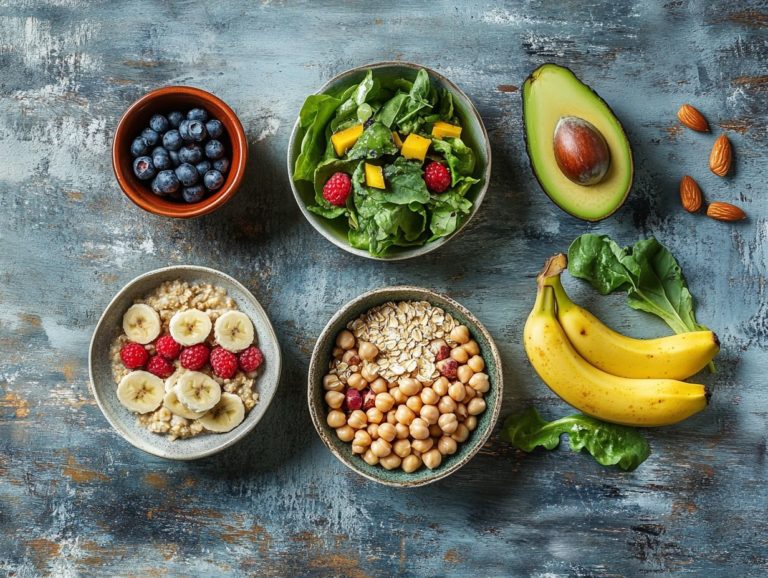How to Incorporate More Whole Foods
Eating whole foods isn t merely a trend; it s a lifestyle choice that holds the power to transform your health and well-being.
By embracing whole foods, you can significantly boost your nutritional intake and enhance your overall vitality. This guide will equip you with the tools to seamlessly incorporate more whole foods into your diet, whether you opt for gradual changes or a complete overhaul.
It will tackle common challenges you might face, such as time and budget constraints, while also sharing creative recipes that make whole foods enjoyable even for the pickiest of eaters.
Start your journey today!
Contents
- Key Takeaways:
- Benefits of Whole Foods
- Ways to Incorporate More Whole Foods into Your Diet
- Common Obstacles and How to Overcome Them
- How to Make Whole Foods More Appealing
- Preguntas Frecuentes
- Qu son los alimentos integrales?
- Por qu incluir m s alimentos integrales en mi dieta?
- C mo puedo empezar a incorporar m s alimentos integrales en mi dieta?
- Hay formas econ micas de incorporar m s alimentos integrales en mi dieta?
- Puedo seguir comiendo alimentos procesados mientras incorporo m s alimentos integrales en mi dieta?
- Hay alg n consejo para permanecer en el camino de incorporar m s alimentos integrales en mi dieta?
Key Takeaways:
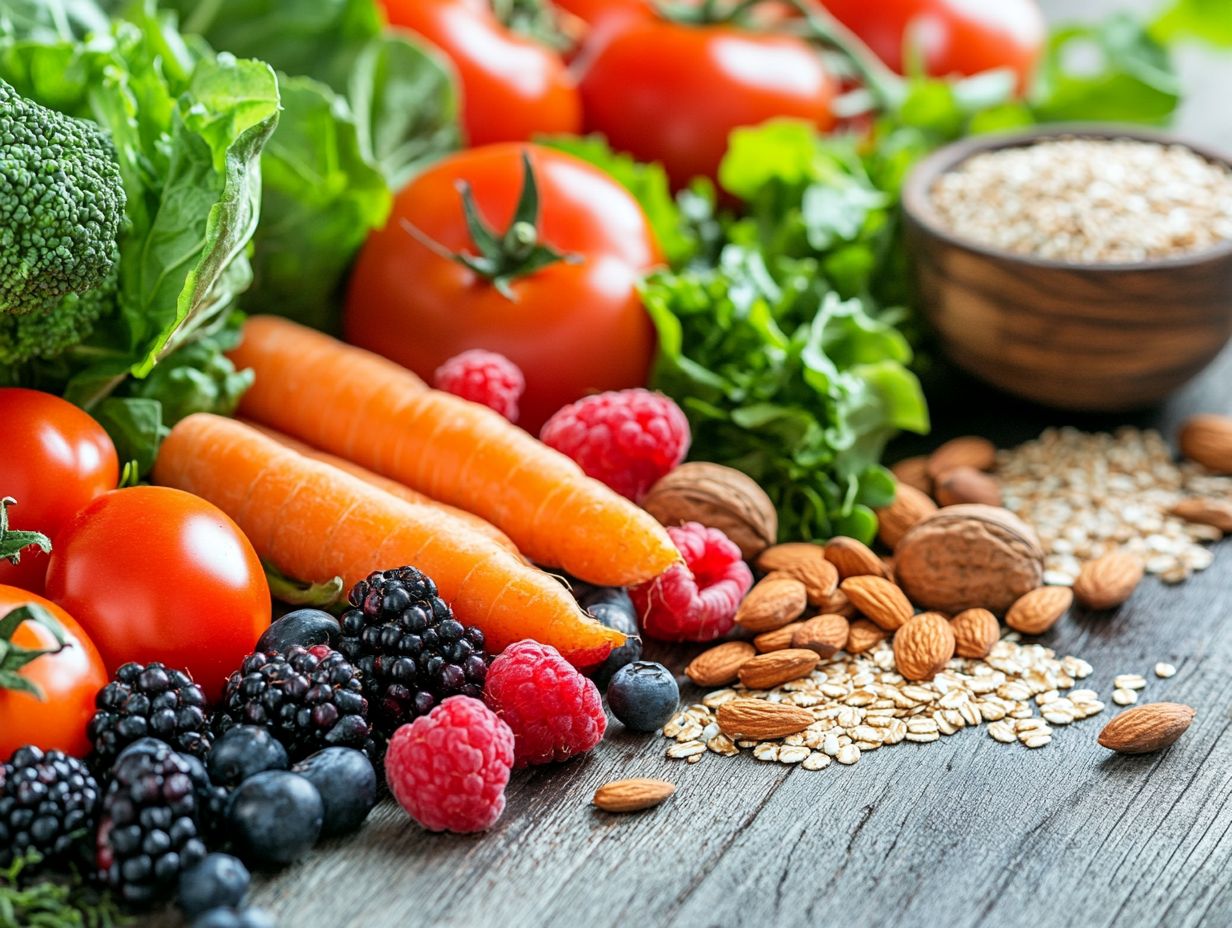
Incorporating more whole foods into your diet has numerous benefits, including improved nutrition and overall health. Start small with gradual changes and utilize meal planning and preparation techniques. To enhance your meals, consider how to incorporate superfoods into your meal plan to make whole foods more appealing. Get creative with recipes and involve picky eaters in the preparation process.
Benefits of Whole Foods
Embracing a whole foods diet presents a multitude of health benefits that extend far beyond mere nutrition. It acts as a great source of nutrients, delivering essential vitamins, minerals, and fiber while actively supporting the prevention of chronic diseases.
By prioritizing nutrient-rich foods like whole grains, lean meats, fruits, and vegetables, you can notably diminish the risk of chronic conditions such as type 2 diabetes and heart disease.
The Academy of Nutrition and Dietetics advocates for the inclusion of these wholesome foods in your daily meal planning to elevate your overall health and well-being.
Nutritional Advantages
The nutritional advantages of a whole foods diet are truly remarkable. Incorporating nutrient-dense foods that are minimally processed and abundant in essential nutrients is key.
Consider legumes, quinoa, Brussels sprouts, and kale. Each one boasts its own unique health benefits:
- Legumes are brimming with protein and fiber, promoting satiety and supporting your weight management efforts.
- Quinoa is a complete protein source, making it an excellent choice for anyone aiming to maintain muscle health while embracing a plant-based lifestyle.
- Brussels sprouts and kale are rich in vitamins C and K, along with antioxidants that help combat inflammation.
The high fiber content of these foods plays a crucial role in digestive health, aiding in regular bowel movements and nurturing a healthy gut microbiome.
This balance is vital for your overall well-being, as a well-functioning digestive system enhances nutrient absorption, boosts immunity, and improves your mood.
Impact on Overall Health
The impact of a whole foods diet on your overall health is profound. It serves as a cornerstone for chronic disease prevention and enhancing your well-being.
Research consistently shows that regularly incorporating whole foods like vibrant fruits, crisp vegetables, hearty whole grains, wholesome nuts, and protein-rich legumes can significantly lower your risk of developing conditions like heart disease and chronic kidney disease.
For instance, a study published in the Journal of the American Heart Association illustrates that diets abundant in whole foods are linked to a remarkable 20% reduction in heart disease risk.
Similarly, the American Journal of Kidney Diseases highlights that embracing plant-based whole foods can bolster kidney function, reducing the chances of progression to chronic kidney disease.
Ways to Incorporate More Whole Foods into Your Diet
Start incorporating whole foods into your diet today and watch your health transform! By gradually embracing clean eating practices and aligning your food choices with established dietary guidelines, you can seamlessly transition to a whole foods diet. For instance, learn how to incorporate whole grains into meals to emphasize nutrient-dense options.
Meal planning is essential in this journey. Plan your meals to include whole foods and enjoy delicious, nutritious options every day.
Gradual Changes vs. Complete Overhaul

When you decide to transition to a diet that focuses on whole foods, such as fruits and vegetables, rather than processed foods, you’ll often find yourself at a crossroads. Should you make gradual changes or dive headfirst into a complete overhaul of your eating habits?
This choice will significantly shape your journey toward healthier eating. It influences not only your physical well-being but also your mindset around food.
Gradually integrating whole foods allows for a smoother transition. You can start by swapping processed snacks for fresh fruits or veggies, easing into this new lifestyle without feeling like you ve jumped into the deep end.
For instance, rather than eliminating all fast food right away, consider making a homemade version of your favorite dish. It’s a delicious compromise. On the flip side, making an immediate shift to clean eating can be invigorating and yield quick results, though it might be a bit overwhelming for some.
Meal prepping can be a game changer, no matter which route you choose. If you opt for gradual changes, preparing simple recipes with whole ingredients in advance can streamline your weeknight dinners.
For those embracing a full overhaul, making large amounts of food at once to save time during the week, or batch cooking, a variety of meals can ensure you re always set up for success on your new path.
Meal Planning and Preparation Tips
Effective meal planning and preparation are crucial for seamlessly incorporating more whole foods into your diet. This ensures you always have a steady supply of nutrient-rich options at home.
By thoughtfully weaving whole grains, seasonal fruits, and vibrant vegetables into your weekly menus, you can craft meals that are not only healthful but also visually stunning.
Consider designating a specific day for meal prep. This allows you ample time to wash, chop, and store your ingredients for effortless access throughout the week.
Embrace batch cooking techniques like whipping up a large pot of quinoa or roasting an assortment of vegetables to save invaluable time.
Adhering to dietary guidelines fosters balance. Pairing a whole grain with lean protein and a colorful medley of veggies helps ensure that each meal is both satisfying and nourishing.
Keeping a well-stocked pantry filled with versatile whole food staples will streamline your cooking process. This makes the journey toward healthier eating a breeze.
Common Obstacles and How to Overcome Them
Transitioning to a whole-foods diet comes with challenges like time and budget constraints. These can be significant hurdles for anyone striving to embrace healthier eating habits.
Time and Budget Constraints
Time and budget constraints can pose significant barriers when you’re trying to embrace a whole-foods diet focused on clean eating. It s all too easy to fall back on quick, unhealthy food choices that may feel more convenient and economical in the moment.
However, with a bit of planning and strategic grocery shopping, you can navigate these challenges. One effective strategy is to create a weekly meal plan that highlights seasonal produce and straightforward recipes.
By buying in bulk and taking advantage of sales, you can significantly reduce your grocery expenses. Incorporating batch cooking into your routine ensures that healthy meals are on hand throughout the week. This saves you both time and money while maintaining your nutritional goals.
Dealing with Picky Eaters
Dealing with picky eaters can be one of the most challenging aspects of embracing a whole-foods diet, especially when it comes to introducing new fruits and vegetables.
To tackle this culinary challenge, employ innovative strategies that not only enhance the appeal of these nutrient-rich foods but also spark curiosity. One effective approach is to transform the presentation of fruits and vegetables into vibrant, playful arrangements that resemble fun shapes or familiar characters.
- Think colorful fruit kabobs,
- whimsical vegetable rainbow platters,
- or even smoothies that incorporate a variety of colorful ingredients to cleverly mask the taste of less favored items.
Involving children or picky eaters in meal preparation can cultivate a sense of ownership. This encourages them to experiment with different whole-food combinations and gradually expand their preferences.
How to Make Whole Foods More Appealing
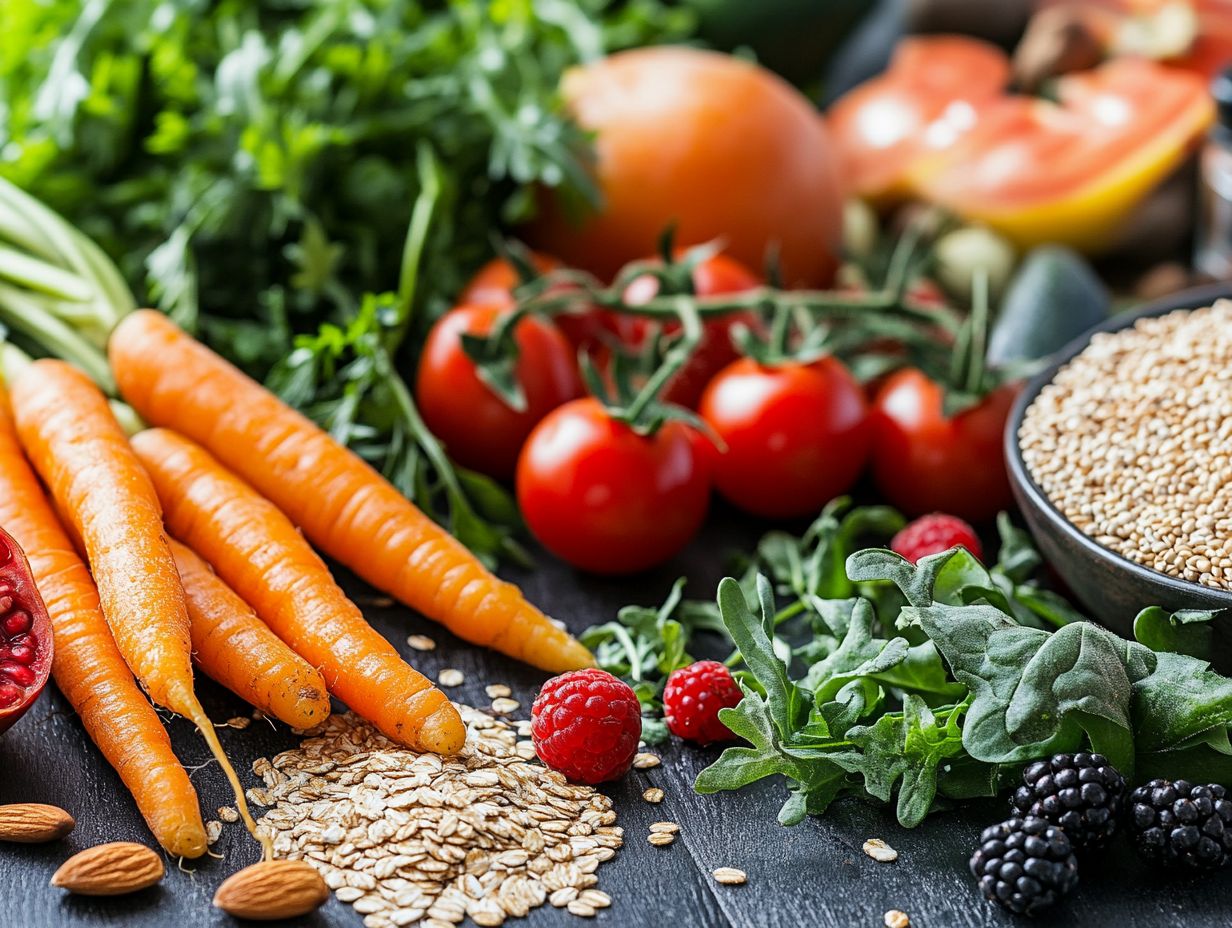
Making whole foods appealing is essential for you as you transition to a whole-foods diet. With some creative recipes and thoughtful meal planning, you can transform the traditional views of healthy eating, making it not just nutritious but truly delightful.
Creative and Delicious Recipes
Creative and delicious recipes can turn a whole-foods diet into an enjoyable journey. You can introduce a mix of tasty flavors and textures that truly excite your palate.
By incorporating healthy ingredients such as vibrant fruits, fresh vegetables, hearty whole grains, and versatile legumes, you can craft meals that are both satisfying and wholesome.
For example, try a colorful quinoa salad tossed with roasted sweet potatoes, black beans, and a zesty lime dressing. This dish bursts with nutrients and flavor that’s hard to resist.
When you prepare meals using techniques like steaming or baking, you not only retain the natural flavors and nutrients but also elevate the overall dining experience. Each dish becomes a delightful adventure.
This approach invites you to explore and unleash your creativity in the kitchen, allowing you to maintain a balanced diet while savoring every delicious bite.
Tips for Picky Eaters
When tackling the challenges that come with picky eaters, it s crucial to adopt strategies that encourage the acceptance of whole foods in their diet.
One effective method is to gradually introduce a variety of food choices without overwhelming them. Add one new ingredient at a time to their familiar dishes to make the transition feel less intimidating.
Creative presentation is important; arranging food in fun shapes or using vibrant colors can spark interest and stimulate curiosity.
Involving them in meal preparation or establishing themed dinner nights can create a positive atmosphere for trying new foods. Ultimately, patience and consistent exposure are your best allies in expanding their palate and promoting a balanced diet.
Preguntas Frecuentes
Qu son los alimentos integrales?
Los alimentos integrales son alimentos naturales y no procesados que est n libres de aditivos, conservantes e ingredientes artificiales. Ejemplos incluyen frutas, verduras, granos enteros, nueces y semillas.
Por qu incluir m s alimentos integrales en mi dieta?
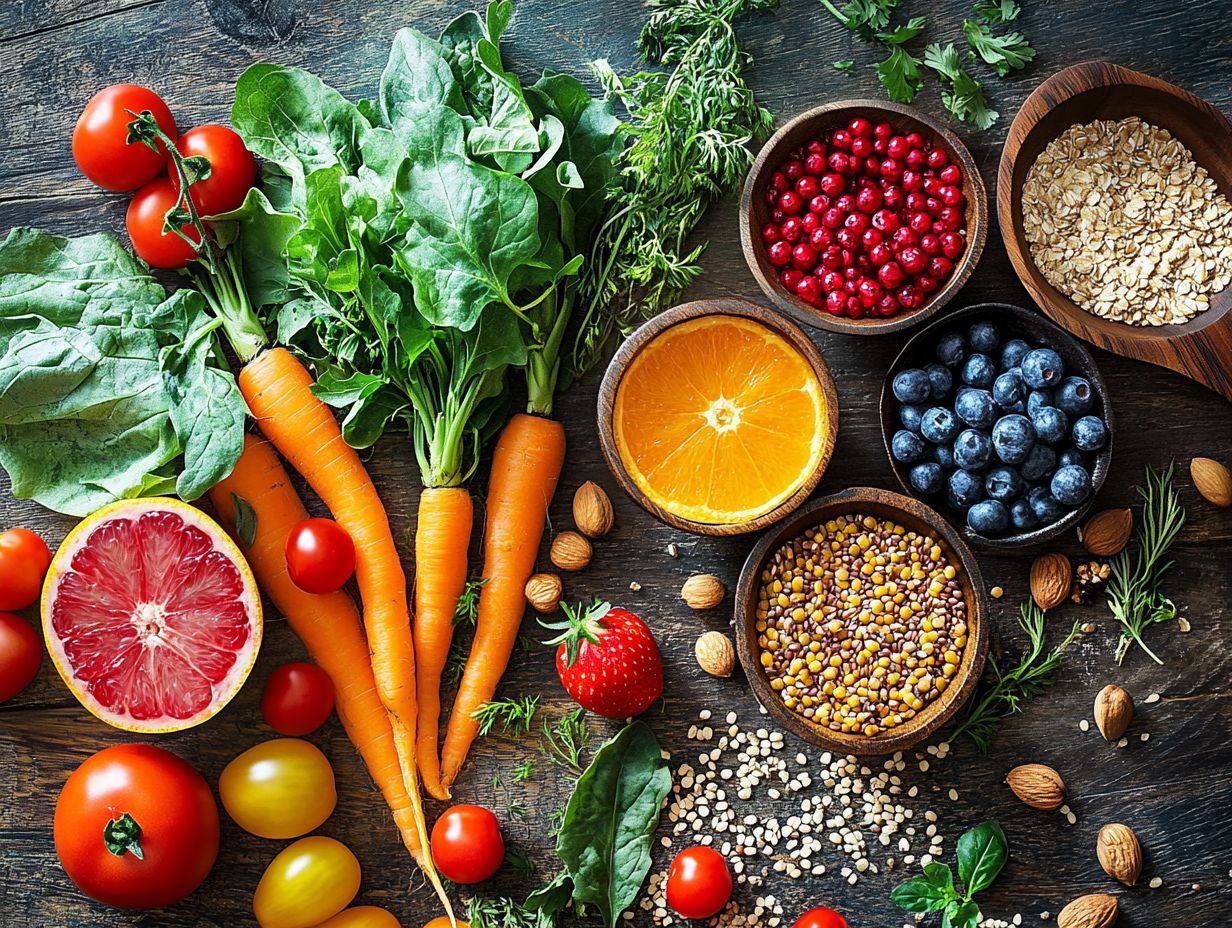
Incorporar m s alimentos integrales en su dieta puede proporcionar numerosos beneficios para la salud, incluyendo mayor energ a, mejor digesti n, manejo del peso y un menor riesgo de enfermedades cr nicas.
C mo puedo empezar a incorporar m s alimentos integrales en mi dieta?
Puede comenzar reemplazando gradualmente los alimentos procesados con alimentos integrales en sus comidas y refrigerios. Elija frutas y verduras enteras en lugar de jugos, opte por granos integrales como quinoa o arroz integral en lugar de granos refinados, y a ada nueces o semillas a sus ensaladas y yogur.
Hay formas econ micas de incorporar m s alimentos integrales en mi dieta?
S , hay muchas opciones de alimentos integrales asequibles, como frutas y verduras congeladas, compras al por mayor de granos y legumbres, y compra de productos de temporada. Tambi n puede consultar las ofertas y descuentos en su tienda de comestibles local o mercado de agricultores.
Puedo seguir comiendo alimentos procesados mientras incorporo m s alimentos integrales en mi dieta?
S , se trata de equilibrio. No tiene que eliminar completamente los alimentos procesados de su dieta, pero intente hacer de ellos una parte m s peque a de su ingesta total de alimentos. Conc ntrese en incorporar m s alimentos integrales en sus comidas y refrigerios, mientras se permite disfrutar de los alimentos procesados con moderaci n.
Hay alg n consejo para permanecer en el camino de incorporar m s alimentos integrales en mi dieta?
Planifique sus comidas y snacks ahora! Esto har que a adir comida saludable a su dieta sea m s f cil.
Prepare algunos ingredientes por adelantado. Pruebe nuevas recetas y alimentos para mantener su dieta interesante.

